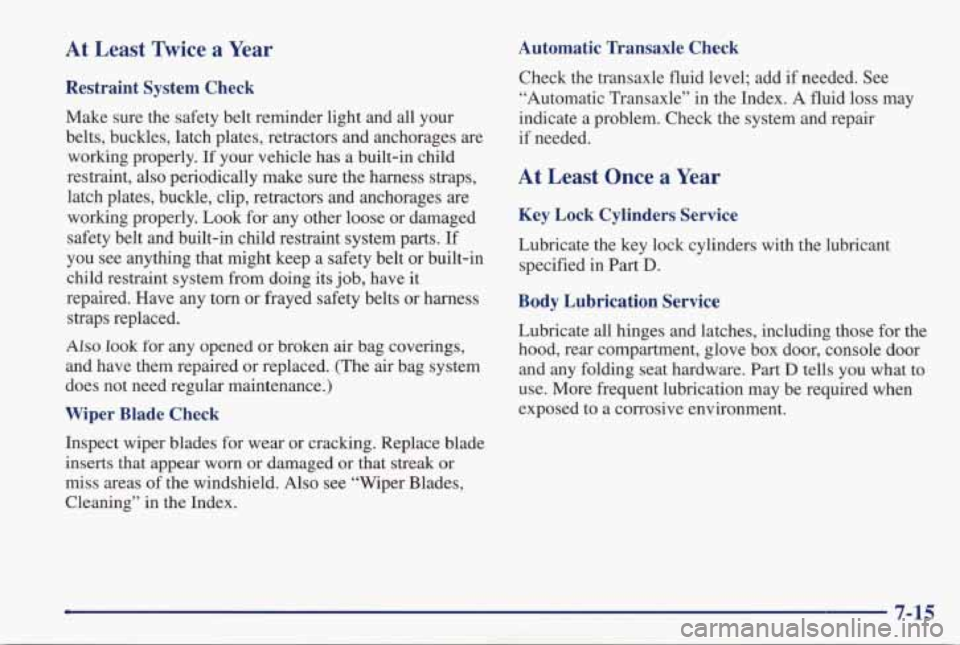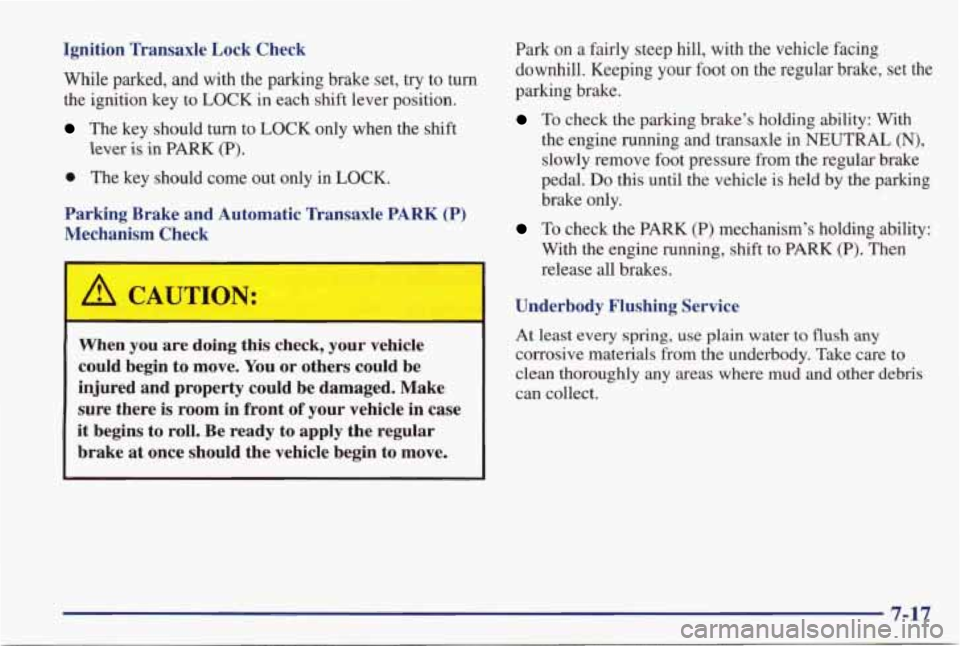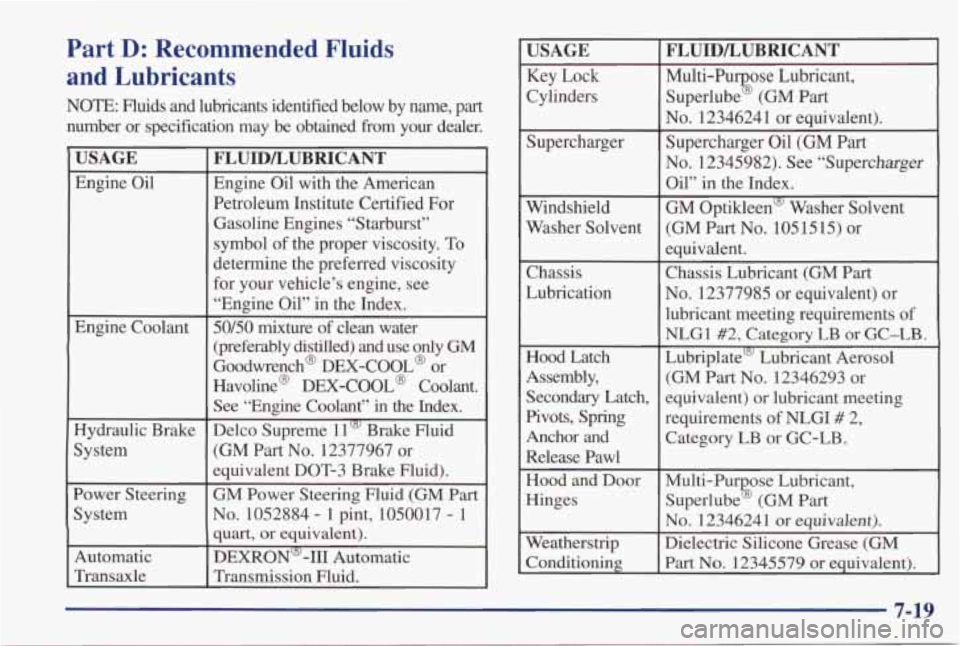Page 338 of 402

Windshield Wipers
The windshield wiper motor is protected by a circuit
breaker and a fuse.
If the motor overheats due to heavy
snow, etc., the wiper will stop until the motor cools.
If
the overload is caused by some electrical problem, have
it fixed.
Power Windows and Other Power Options
Circuit breakers in the fuse panel protect the power
windows and other power accessories. When the current
load is too heavy, the circuit breaker opens and closes,
protecting the circuit until the problem is fixed.
Instrument Panel Fuse Block
Some fuses are in a fuse block located inside of the glove
box behind a
small bin, on the right side. To open, pull on
the plastic strap
and pull the cover out. The fuse block is
inside.
On the back edge of this cover is a fuse puller and
a fuse usage chart. To use the fuse puller, place the wide
end
of the fuse puller over the plastic end of the fuse.
Squeeze the ends over the fuse and pull it out.
To reinstall the bin, position the lower end and turn
the top into position. Press on the sides until
it snaps
into place.
6-63
Page 339 of 402

FUSE USAGE CHART I See Underhood Electrical
Center For Spare Fuses I I I I
CIRCUIT BREAKERS
I HEADLAMP I
I I MAUPGM
STR WHL STR WHL
CTRL
I
I I PWR LOCK I I
RAP HAZARD ~
GIG LTR
I/P - IGN
CRUISE
ECM STOP LAMP
INT LAMP
ABS
PWR DROP MALL
WIPER
SUNROOF
CD CHG
AUWCNSL HVAC
HI PWR MIR
R DEFOG
HSEATILUM
RADIO
SIR TURN
BTSl
HVAC CTRL DlCRlVAC
I I I I CANISTER DRL VENT
rinted in USA.
For More Information, See Owner’s Manual 10401979)
Description
Circuit
Breaker
HEADLAMP
Headlamps
SEAT Power Seat, Power Lumbar
PWR WDO Power Windows
Fuse Description
MALL PGM Mall Module -- Program
MALL Mall Module
Fuse
WIPER
STR WHL
STR WHL
CTRL
SUNROOF
RADIO
PWR LOCK
HSEATLUM
R DEFOG
RAP
HAZARD
PWR MIR HVAC
HI
CIG LTR
INT LAMP STOP LAMP
Description
Wipers
Steering Wheel Illumination
Steering Wheel Control
Sunroof
Radio, Antenna
Mall Module
-- Power Locks
Heated Seats, Power Lumbar
Rear Defog
Retained Accessory Power, Mall Module
Hazard Flashers
Power Mirrors
HVAC Blower -- Hi
Cigarette Lighter,
ALDL, Floor
Console Auxiliary Outlet
Mall Module
-- Interior lamps
S toplamp
6-64
Page 340 of 402
AUWCNSL CD CHG
ECM
CRUISE
UP-IGN
SIR
TURN
ABS
BTSI
PWR DROP HVAC CTRL
DIC/HVAC
DRL Auxiliary Power, Overhead Console
CD Changer
Underhood Electrical Center
-- Passenger’s Side
ECM
Cruise Control
ChimeNall Module, Cluster, Trip
Computer, Head-Up Display,
Brake-Transaxle Shift Interlock
Supplemental Inflatable Restraint
Turn Signal
(Air Bag)
Anti-Lock Brakes
PRNDL, Brake-Transaxle Shift Interlock
Power Drop Ignition
Blower Control, HVAC
Rear Defog, HVAC, Driver
Information Center, Daytime
Running Lamps, Heated Seats
Canister
Vent Solenoid
Daytime Running Lamps Some fuses are in a fuse block on the passenger’s side
of
the engine compartment. Pull
off the cover labeled
FUSES
to expose the fuses.
6-65
Page 360 of 402

At Least Twice a Year
Restraint System Check
Make sure the safety belt reminder light and all your
belts, buckles, latch plates, retractors and anchorages are working properly. If your vehicle has
a built-in child
restraint, also periodically make sure the harness straps, latch plates, buckle, clip, retractors and anchorages
are
working properly. Look for any other loose or damaged
safety belt and built-in child restraint system parts. If
you see anything that might keep a safety belt or built-in
child restraint system from doing its job, have it
repaired. Have any torn or frayed safety belts or harness
straps replaced.
Also look for any opened or broken air bag coverings,
and have them repaired or replaced. (The air bag system
does not need regular maintenance.)
Wiper Blade Check
Inspect wiper blades for wear or cracking. Replace blade
inserts that appear
worn or damaged or that streak or
miss areas of the windshield. Also see “Wiper Blades,
Cleaning” in the Index.
Automatic Transaxle Check
Check the transaxle fluid level; add if needed. See
“Automatic Transaxle” in the Index. A fluid loss may
indicate a problem. Check the system and repair if needed.
At Least Once a Year
Key Lock Cylinders Service
Lubricate the key lock cylinders with the lubricant
specified in
Part D.
Body Lubrication Service
Lubricate all hinges and latches, including those for the
hood, rear compartment, glove box door, console door
and any folding seat hardware.
Part D tells you what to
use. More frequent lubrication may be required when
exposed to a corrosive environment.
7-15
Page 361 of 402

Starter Switch Check
1-
Brake-Transaxle Shift Interlock (BTSI) Check
r-
When you are doing this check, the vehicle could move suddenly.
If it does, you or others could be
injured. Follow the steps below.
A CAUTION:
When you are doing this check, the vehicle could
move suddenly.
If it does, you or others could be
injured. Follow the steps below.
1.
2.
3.
Before you start, be sure you have enough room
around the vehicle.
Firmly apply both the parking brake (see “Parking
Brake” in the Index if necessary) and the
regular brake.
NOTE: Do not use the accelerator pedal, and be
ready to
turn off the engine immediately if it starts.
Try to start the engine in each gear. The starter
should work only
in PARK (P) or NEUTRAL (N). If
the starter works in any other position, your vehicle
needs service.
1. Before you start, be sure you have enough room
around the vehicle. It should be parked on a
level surface.
2. Firmly apply the parking brake (see “Parking Brake”
in the Index if necessary).
NOTE: Be ready to apply the regular brake
immediately if the vehicle begins to move.
3. With the engine off, turn the key to the RUN
position, but don’t start the engine. Without applying
the regular brake,
try to move the shift lever out of
PARK
(P) with normal effort. If the shift lever
moves out
of PARK (P), your vehicle’s BTSI
needs service.
7-16
Page 362 of 402

Ignition Transaxle Lock Check
While parked, and with the parking brake set,
try to turn
the ignition key to LOCK in each shift lever position.
The key should turn to LOCK only when the shift
lever is in PARK (P).
0 The key should come out only in LOCK.
Parking Brake and Automatic Transaxle PARK
(P)
Mechanism Check
1
Park on a fairly steep hill, with the vehicle facing
downhill. Keeping your foot on the regular brake, set the
parking brake.
To check the parking brake’s holding ability: With
the engine running and transaxle in
NEUTRAL (N),
slowly remove foot pressure from the regular brake
pedal. Do this until the vehicle is held by the parking
brake only.
To check the PARK (P) mechanism’s holding ability:
With the engine running, shift to
PARK (P). Then
release
all brakes.
Underbody Flushing Service
At
least every spring, use plain water to flush any
corrosive materials from the underbody. Take care to
clean thoroughly any areas where mud and other debris
When you are doing this check, your vehicle
could begin
to move. You or others could be
injured and property could be damaged. Make
it begins to roll. Be ready to apply the regular
sure there
is room in front of your
vehicle in case can collect.
brake
at once should the vehicle begin to move.
Page 364 of 402

Part D: Recommended Fluids
and Lubricants
NOTE: Fluids and lubricants identified below by name, part number or specification may
be obtained from your dealer.
USAGE
Engine Oil
Engine Coolant
Hydraulic Brake
System
Power Steering
System
Automatic
Transaxle
FLUIDLUBRICANT
Engine Oil with the American
Petroleum Institute Certified For
Gasoline Engines “Starburst” symbol of the proper viscosity.
To
determine the preferred viscosity
for your vehicle’s engine, see
“Engine Oil” in the Index.
50/50 mixture of clean water
(preferably
distilled) and use only GM
Goodwrench@ DEX-COOL@ or
Havoline@ DEX-COOL@ Coolant.
See “Engine Coolant” in the Index.
Delco Supreme 11
vv Brake Fluid
(GM Part No. 12377967 or
equivalent DOT-3 Brake Fluid).
GM Power Steering Fluid (GM
Part
No. 1052884 - 1 pint, 1050017 - 1
quart, or equivalent).
DEXRONw-I11 Automatic
Transmission Fluid. -
USAGE
Key Lock
Cylinders
Supercharger
Windshield
Washer Solvent
Chassis
Lubrication
Hood Latch
Assembly, Secondary Latch,
Anchor and Pivots, spring
Release Pawl
Hood and Door Hinges
Weatherstrip
Conditioning
FLUIDLUBRICANT
Multi-Pu ose Lubricant,
Superlube
% (GM Part
No. 12346241 or equivalent).
Supercharger Oil (GM
Part
No. 12345982). See “Supercharger Oil” in the Index.
GM Optikleenw Washer Solvent
(GM
Part No. 1051515) or
equivalent.
Chassis Lubricant
(GM Part
No. 12377985 or equivalent) or
lubricant meeting requirements of
NLG1#2, Category LB
or GC-LB.
Lubriplate” Lubricant Aerosol (GM
Part No. 12346293 or
equivalent) or lubricant meeting
requirements of NLGI
# 2,
Category LB or GC-LB.
Multi-Pu ose Lubricant, Superlube
% (GM Part
No. 12346241 or equivalent).
Dielectric Silicone Grease (GM
Part No. 12345579 or equivalent).
7-19
Page 373 of 402
Pontiac Roadside Assistance Program
L
Security While You Travel
I-800-ROADSILE (1-800-762-3743)
As the proud owner of a new Pontiac vehicle, you are
automatically enrolled in the Pontiac Roadside Assistance program.
This value-added service is
intended to provide you with peace of mind as you
drive in the city or travel the open road.
Pontiac’s Roadside Assistance toll-free number
is
staffed by a team of technically trained advisors, who
are available
24 hours a day, 365 days a year.
We take anxiety out of uncertain situations by providing
minor repair information over the phone or
making
arrangements to tow your vehicle to the nearest
Pontiac dealer.
We will provide the following services for
3 years/36,000 miles
(60 000 km), at no expense to you:
a Fuel delivery
a Keys locked in vehicle
a Tow to nearest dealership for warranty service
a Change a flat tire
Jump starts
Courtesy Transportation -- See Pontiac Courtesy
Transportation section for details
8-6